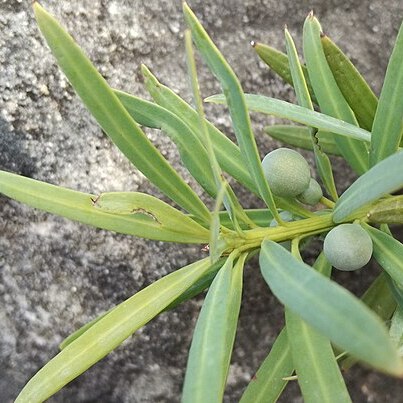Trees or shrubs evergreen, dioecious. Leaves spirally arranged to subopposite, ± monomorphic, juvenile leaves similar to adult leaves in shape but often larger and/or wider, linear, lanceolate, or ovate-elliptic, more than 5 mm, with single, obvious, often raised midvein on 1 or both surfaces, stomatal lines present on abaxial surface. Pollen cone complexes axillary, solitary or clustered, pedunculate or sessile; microsporophylls numerous, spirally arranged; microsporangia 2; pollen 2-saccate. Seed-bearing structures usually borne in leaf axils (rarely terminal), solitary (rarely more than 1); apical bracts fertile; basal bracts often fused to form a receptacle (obsolete in some species); ovule 1 (rarely few), inverted. Epimatium wholly enveloping seed, sometimes colored and succulent. Seed ripening in 1st year, drupelike, dry, or leathery.
Shrubs or trees to 30 m. high, with linear lanceolate leaves spirally arranged, or sometimes opposite or whorled on the same tree, dioecious. Male cones cylindrical, catkin-like, shortly stalked; female cones reduced, of 1 or 2 fertile scales bearing solitary inverted ovules and terminating short scaly or leafy lateral branches. Epimatium sometimes fleshy, entirely enclosing the seed, and fused with the thin or thick woody testa. Receptacle sometimes swollen and fleshy.
Shrubs to tall trees. Leaves spiral (in Panama), laminate, coriaceous, muc-ronate. Strobili dioecious: the staminate terminal or in the axils of the upper leaves, solitary or clustered, cone-like, sporophylls spiral, each bearing 2 micro-sporangia; the ovulate a small bracted spike bearing 1-2 terminal, inverted, naked ovules. Fruit drupaceous, usually fairly large.
Female strobilus of 1 or 2 fertile scales on a bracteolate axis; ovule inverted and soon becoming enclosed in an epimatium (false aril) which arises from the scale and ultimately forms a resinous leathery integument that becomes confluent with the woody testa. Base ("receptacle") of female strobilus sometimes swollen and fleshy at maturity.
Male strobili forming shortly stalked, short catkin-like basally bracteate cones with a pair of ± elliptic pollen-sacs on each median scale.
Leaves linear, lanceolate or narrowly ovate, usually spirally arranged.
Evergreen trees or shrubs, usually dioecious.

